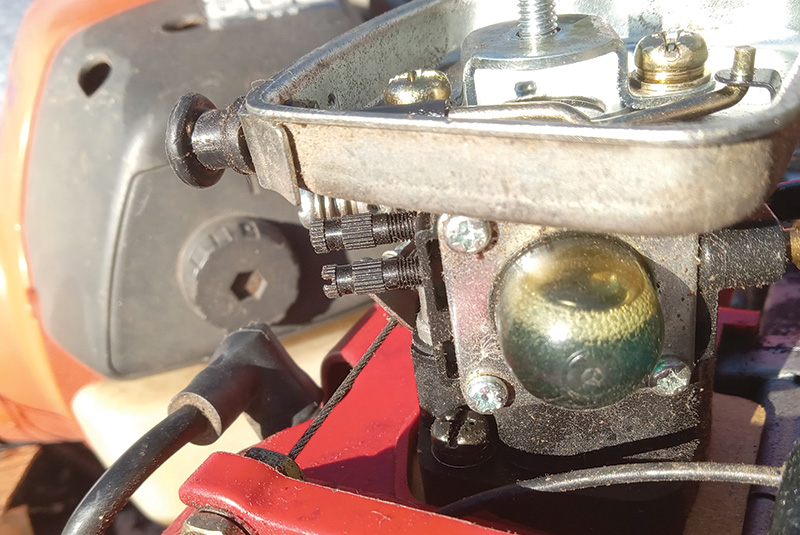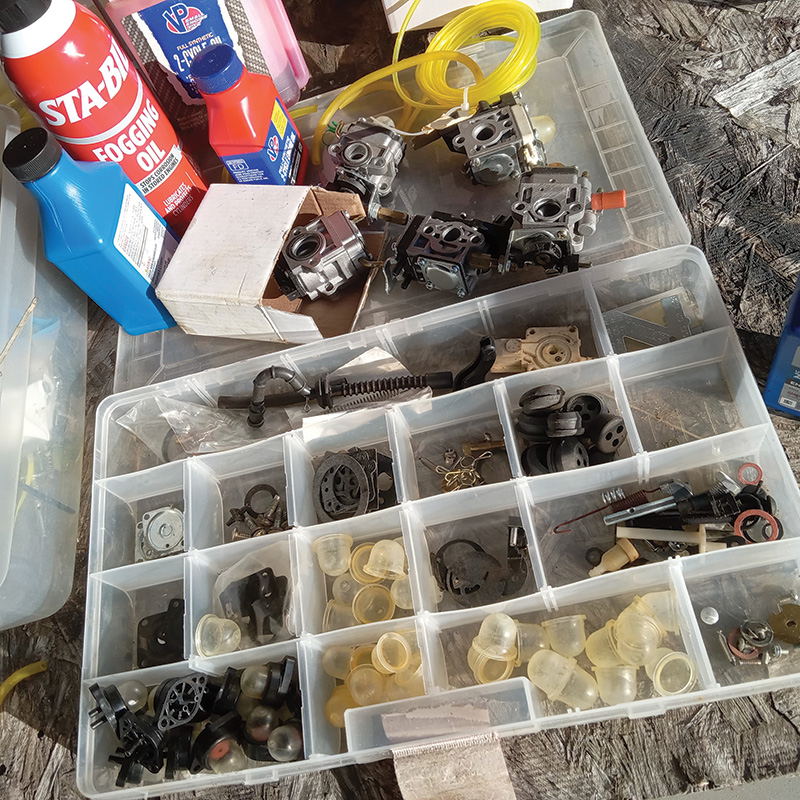
It takes a little more effort, but this primer pump managed to fill the Mantis tiller carburetor with oil for storage. The foam indicated a small air leak in the fuel intake hose, which was replaced when the tiller went back into service. Photos by Scott Nesbitt
This equipment-storage technique worked for me. I’ve never seen it mentioned by any equipment maker, but it makes sense. It might work for your fleet.
The concept is to flood carburetors with two-cycle oil. It made my rarely used old Mantis tiller start quickly after a year in storage. In the past, no matter how I stored it, the 21.2 cc Kioritz-Echo two-cycle engine needed a new or rebuilt carburetor. This year it was running 10 minutes after I blew the dust off.
Traditional storage wisdom says to add some storage additive to the fuel and run the engine until the fuel runs out. In the marine two-cycle world, many advocate protecting the engine’s internals with a shot or two of fogging oil down the carburetor just as the fuel is running out.
Too often, carburetors fail after storage. Varnish formed by old fuel may stick the needle and seat closed or open. Crystalized fuel lumps or rust particles can clog passages in the carb. In diaphragm carbs, the synthetic rubber fuel pump flappers and the metering diaphragm can either turn to jelly or stiffen up and lose the flexibility needed to function.
What happens if you push any remaining traces of gasoline out of the carburetor? You end up with oil-bath storage.
After the tank is empty, add a few ounces of two-cycle oil to the fuel tank and pump the primer bulb until the oil flows out the return line and into the tank. For float bowl carburetors, loosen the bowl drain or the bowl’s center nut until a dollop of oil flows out. Old diaphragm carbs without primer bulbs need to have the starter pulled up to 20 times to move oil into the carb’s interior chambers and passages.
To revive the engine, fill the tank with fresh fuel (or fuel/oil mix) and run the starter. The spark plug may foul from excess oil, and there will be a cloud of smoke as excess oil burns. But chances are good the engine will start and run normally months, or even years, after storage.

A collection of carburetors and various repair parts is no longer needed to bring an engine out of storage, thanks to the oil bath storage system that seems to bypass the carburetor problems experienced with conventional storage techniques.
I came across this concept in 2023 on the YouTube channel of “Chickanic” — a smart woman from Arkansas with years of small-engine repair experience. This particular 13-minute video (https://www.youtube.com/watch?v=hKjfe-9Ykdg) is titled “Save Money on Repairs With This Easy Trick!”
I found the oil-storage concept was confirmed at online forum discussions for the outdoor power, motorcycle and marine communities.
Here are some pointers:
Use only full synthetic two-cycle oil intended for chainsaws and trimmers. You want pure, thin oil without additives that may be used in larger engines. Study of the safety data sheet finds that the cheaper the oil, the fewer the additives. And don’t worry if you leave some oil in the tank before adding new fuel — a little extra lube probably won’t hurt an engine that’s been sitting unused for months or years.
Scott R. Nesbitt is a freelance writer and former GCSAA staff member. He lives in Cleveland, Ga.